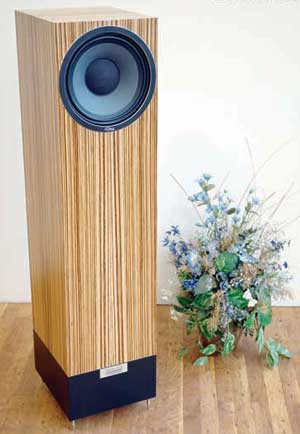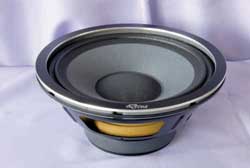| WLM Divas - Made In
Austria
|
The WLM divas
provide out-of-this-world sound whether your taste in amps
is tube or solid state
Specialty high-end manufacturer WLM is located near the
Swiss and German borders in Austria’s Alpine region.
If you are a regular reader, you may recall two recent reviews,
one of the company’s top-of-the-line model, the Gran
Violas (reviewed in Vol. 16, No. 4) and the Auras (reviewed
in Vol. 17, No. 1). Both of these models were designed for
bi or tri-amping and had optional active external crossovers
and modules to enhance the all-round sound.
The Divas are the company’s latest addition and, unlike
its other models, represent a straight-forward design but
with a bit of a twist. WLM chose a dual concentric design,
featuring a 10-inch woofer with a super tweeter centered
behind a small grill. But more on this later.
Appearance
These speakers are tall, relatively slim and bear a resemblance
to the British Living Voice speakers--both accommodate
a tuning port on the black coloured extension under the
finished enclosures. The one visible driver is located
at the upper portion of the enclosure and there is nothing
different in this design from so many other loudspeaker
enclosures—except, perhaps the finish. Our samples
came in the Zebrano finish, but maple and cherry wood veneers
are also available. On the enclosures’ rear, a pair
of WBT terminals allow single wiring only—some manufacturers,
including Focal JMLab swear by this approach. Also on the
rear, a small dial allows adjustment of the tweeter +/-3dB.
The manufacturer refers to using the control to tune room
acoustics, but I suspect that it will be used to please
one’s taste. (I liked it best with the control up
a couple of dBs). The WLMs look great and they’ll
fit into almost any room décor.
|
|
The Sound
As the Divas arrival coincided with that of the new Bryston 28B SST monoblocks
(reviewed in this issue), I connected them for my first auditioning session.
The Wyetech Labs Opal preamplifier (reviewed in Vol. 10, No. 2) and the Simaudio
Andromeda CD player (also reviewed in this issue) completed this system. Bryston’s
James Tanner was on hand to help connect amps and speakers and we fired up the
system. After but a few bars of music, Tanner and I agreed that the Diva/Bryston
combination created a bit of audio magic. Though I expected great imaging, I
did not expect such astounding realism. The musicians were lined up horizontally
on the sound stage and it was crystal clear how they were arranged. In addition
to the awesome horizontal reach way outside the loudspeakers’ edges, depth,
height, spatial elements and focus were evident.
As for the Divas’ sonic signature, I’d say that it is different from
most other loudspeakers in this price range. The Divas left me with the impression
that I wasn’t listening to loudspeakers with obvious markers, but rather
to a curious organic source. Of course, it is my job to find and document shortcomings
and while I found a few “curious” ones, they did not appear with
well-produced listening material. However, a lot of mass produced recordings
revealed a slightly pinched lower midrange around 300Hz. Frequencies below 300Hz
to a fundamental 30Hz note were full-bodied and resolute, clearly demonstrating
the speakers’ ability to recreate harmonics surrounding fundamental tones.
Reasoning that the speakers’ efficiency rating is very high, I connected
the Divas to the 18 watts/channel Weytech Labs Topaz amp (reviewed in the last
issue), connected it with the Simaudio P-8 preamplifier and the Andromeda CD
player (both reviewed in this issue). As expected, the Wyetech Labs single-ended
amp was a great match with the Divas. However, what I had expected to be the
better system combination really wasn’t as the overall sound was almost
identical to the system using the Bryston monoblocks. The midrange and bass areas
did sound a touch richer and the very top frequencies had a little more “sparkle” than
with the Brystons, but the tonal discrepancies were negligible. Imaging was as
good, solid, focused, evidencing plenty of air around instruments and vocals.
|
For another listening test, I connected the Cary SLI 80 integrated
amplifier (reviewed in this issue). Running the amplifier in
the triode and ultra linear modes quickly convinced me that
this was a match made in the proverbial audio heaven. Both
modes sounded good, but I preferred the ultra linear mode as
it introduced more (not better) resolution, which is my preference.
Others, however, preferred the Diva/Cary combination in the
triode mode. I believe that this was the “nicest” sound,
not the most accurate, but certainly the most musically pleasing.
This test leads me to assume that push-pull tube amps such
as the Cary offer remarkable synergy when combined with the
WLM Divas. Those of you with such amps can expect the Divas
to produce 120dB of undistorted music. Dynamics and micro dynamics
were best with the Bryston, closely followed by the Topaz,
but lush, musical potency was best with the Cary Audio amplifier.
|
All system combinations were wired up with Nordost Valhalla cables and later,
with JPS Labs Aluminata cables (reviewed in this issue). While I liked the Valhallas
best with the Topaz and Cary Audio amps, I preferred the JPS Labs with the Bryston
monoblocks in the system.
Synopsis & Commentary
It is very rare to find a loudspeaker that doesn’t speak its own language.
Confused? Well, think of a loudspeaker as a person with his/her specific individuality,
speaking with his/her unique voice and language. All loudspeakers are unique
in voice and dialect, often revealing maker and origin; this is often called
a signature sound. The various tonal differences of loudspeakers are probably
the reason why the market supports so many loudspeaker manufacturers. Many
manufacturers decided a long time ago to provide the kind of sound you may
like and at a price you may find attractive. There are other manufacturers
that design and build loudspeakers that simply are good—and with the
Divas, the WLM folks presented such a design.
If you like a speaker that sounds
a bit forward, or subdued, or “honky” or “boomy” or
other very distinguishing characteristics, the Divas are not for
you. They are for folks who appreciate the unadulterated sound
and timbre of a Stradivarius violin or an Amati bass; or the signature
sound of a certain model Gibson guitar; or the sound of a Steinway
piano. The Divas own “signature sound” is best described
as organic—natural, not artificial or man-made. These loudspeakers
do not get in the way of the music they are asked to reproduce.
They will sound good with tube and solid-state amps (you can choose
what you like) as long as they are of good quality. When wired
up with compatible cables (the two brands I used qualify), you
can expect to hear a well-balanced sonic performance, smooth over
the entire frequency spread and ever so musical. The bass is surprisingly
quick, the mids are sweet and the highs are delicate, but the best
thing about these loudspeakers is their ability to create superb
multidimensional image. It’s out of the box, out of the room,
heck, it’s out of this world. Try a pair, you may like them
as much as I did.
| MODELS |
MANUFACTURER |
| WLM Divas |
Wiener Lautsprecher Manufacktur |
| RATING |
CONTACT |
♪♪♪♪
|
800.330.3804 |
| PRICE |
FINISH OPTIONS |
$5,900 CDN
$5,500 US |
|
| Dimensions |
Weight |
110 cm (h) 26.5 cm (w) 30 cm (d)
|
26 Kg each |
|
 |
TECHNOLOGY
While dual concentric designs have been used by many, Tannoy
made the most of it. WLM’s design is similar, except
that it (again) hides the tweeter behind a cloth, and it is
difficult to even begin to guess what brand or who’s
design is working behind that sonically transparent cover.
Whatever it is, it works very well and has a unique, very smooth
sonic attribute, even when it is stressed to its upper limit—about
30kHz. Each speaker has a single down-firing port with extension
tubes to allow appropriate tuning to the listening room’s
acoustic.
Spikes at the bottom of the enclosures elevate the
loudspeakers to the height needed for bass frequencies to function
properly. The enclosures are made of 22mm thick MDF and are
well braced with solid hardwood to increase structural stability
and reduce unwanted resonance.
The concentric driver assembly
consists of a medium/low chassis on which the company’s
super tweeter is mounted. The 10 inch woofer boasts, again,
a doped paper cone made by the US company Eminence Technology.
The forthright and uncomplicated hook-up arrangement will appeal
to all who shy away from potentially complicated components.
These loudspeakers have an efficiency rating of 97dB and a
range from 27Hz to 30kHz. |
|



